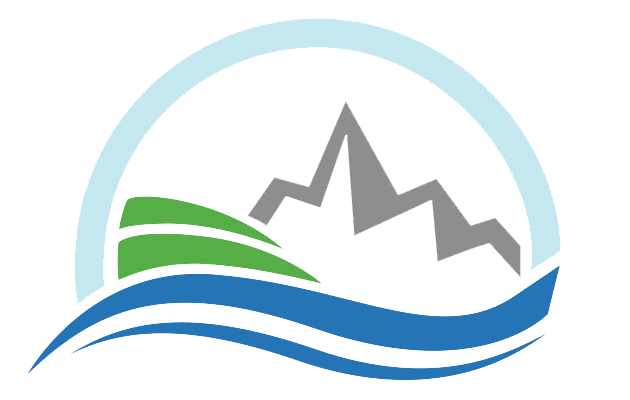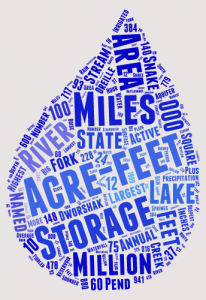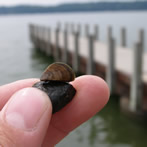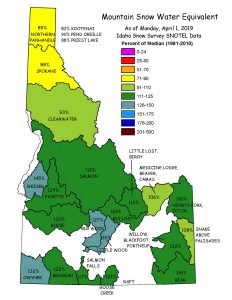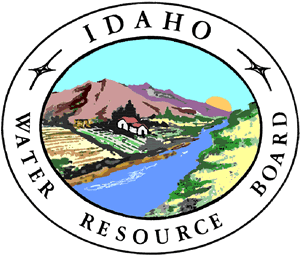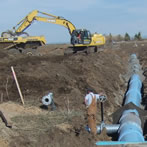| 2016 |
The Big Lost River Subbasin (17040218) is in south central Idaho. This subbasin is one of four subbasins known as the Sinks Drainages because surface waters sink into the Snake River Plain Aquifer. Groundwater flows southwest toward Thousand Springs near Hagerman, Idaho, where the water emerges from springs. Natural discharge from the Snake River Plain Aquifer within the Thousand Spring area contributes 70 percent of the Snake River flow between the Milner Dam and King Hill. This flow is critically important as irrigation diversions at Milner Dam can reduce the Snake River flows to zero.
The current NHD does not reflect changes seen on the ground. IDWR proposes to update the area indicated in Subbasin 17040218 and submit all changes to the USGS for inclusion in the NHD. They will update this area using NAIP imagery, historical maps, and local data (if available). When the initial update is complete, additional input will be solicited from local irrigation companies and interested stakeholders.
| HU 17040218 | USGS |
| 2016 |
The Lemhi River Subbasin (17060204) is in central Idaho. This subbasin is part of the Salmon River Drainage. The eastern edge of this basin follows the continental divide as well as the state boundary. The primary river in this hydrologic unit is the Lemhi River. The Upper Lemhi River Subbasin is an area of high ecological value. It provides the majority of the Endangered Species Act (ESA) listed spring Chinook salmon spawning habitat in the basin. It also provides habitat to ESA-listed steelhead trout and resident bull trout. Numerous state, federal, county, tribal, and non-profit entities are actively engaged in restoration efforts to address factors limiting the distribution and productivity of these species. These entities include Idaho Fish and Game, Idaho Water Resource Board, Idaho Governor's Office of Species Conservation, Idaho Department of Environmental Quality, Lemhi County Soil and Water Conservation District, US Forest Service, US Bureau of Land Management, US Bureau of Reclamation, Shoshone Bannock Tribes, The Nature Conservancy, Trout Unlimited, and the Lemhi Regional Land Trust.
The current NHD does not reflect changes seen on the ground. IDWR proposes to update the area indicated in Subbasin 17060204 and submit all changes to the USGS for implementation in the NHD. They will update this area using NAIP imagery, historical maps, and local data (if available). The update will include a photo revision of existing digital hydrography and the addition of key priority tributaries or irrigation ditches that are not currently in the NHD. Also, key features like fish screens, passage barriers, and ongoing monitoring sites will be added as event features.
| HU 17060204 | USGS |
| 2015 |
The Weiser River subbasin consists of the hydrologic unit (HU) 17050124 in southwest Idaho. The primary river in this subbasin is the Weiser River. The HU17050124 includes 16 water delivery organizations and the small towns of Council, Cambridge, and Midvale. Although there are several dams in HU 17050124, the Weiser River is unregulated.
In the early 1970s, Federal lands for the potential Galloway dam and reservoir site were classified and withdrawn for hydropower purposes by the Federal Power Commission (now the Federal Energy Regulatory Commission). In 2008, the Idaho Water Resource Board was directed by the Idaho Legislature to investigate water storage projects statewide—including the Weiser-Galloway Project. The Weiser-Galloway project area is located approximately at river mile 13.5 on the Weiser River.
Hydrography in subbasin 17050124 is complex because of numerous irrigation canals, laterals, and drainage channels. Irrigation wasteways return flow on both sides of the Weiser River. Because of changes in agricultural practices and the irrigation diversions that have been implemented, the current NHD does not accurately reflect changes seen on the ground. IDWR will update the area indicated in Figure 1 of the Project Proposal and submit all changes to the USGS for inclusion in the NHD. IDWR will update this area using NAIP imagery, historical maps, and local data (if available). At the beginning of this project, additional input will be solicited from local irrigation companies. This project has been funded by USGS and IDWR.
| HU 17050124 | USGS |
| 2014 |
Most of Idaho is in the Pacific Northwest Region Hydrologic Unit Code (HUC) starting with 17, but the southeastern corner of Idaho is the Great Basin Region (HUC starting with 16), specifically the Bear Basin. The Bear River is one of the largest streams in North America whose waters do not reach an ocean; beginning from Utah's Uinta Mountains, flowing a total of 500 miles through three states (Utah, Wyoming, and Idaho), and ending at the Great Salt Lake—only 90 miles from headwaters to mouth. There are 5 subbasins within the Bear River Drainage. Four subbasins are in Idaho: 16010102 Central Bear, 16010201 Bear Lake, 16010202 Middle Bear, and 16010204 Lower Bear-Malad.
Accurate information is needed in discussing and resolving water issues. Updated NHD would allow for an easier exchange of information and a useful dataset for modeling and events. The Bear Basin is also used in water rights accounting, and accurate NHD would assist in that effort as well. IDWR will update areas within the Bear River basin in Idaho using NAIP imagery, historical maps, and local data. With this project, additional input will be solicited from local irrigation companies and interested stakeholders. This project has been funded by USGS and IDWR.
| HU 16010202 | USGS |
| 2014 |
The Great Feeder Canal system, located five miles east of the town of Ririe, Idaho, was dedicated in June, 1895. This canal system is the largest irrigating system in the Upper Snake River Valley and one of the largest systems in the West. It supplies water for 20 major canal systems and diverts up to one million acre-feet of water. Over the years, a vast amount of construction and almost continual repair work has taken place on the canal system, and the current NHD does not reflect changes seen on the ground. IDWR will update this area in Idaho using NAIP imagery and any available historical maps and local data. With this project, additional input will be solicited from local irrigation companies and interested stakeholders. This project has been funded by USGS and IDWR.
| HU 17040201 | USGS |
| 2014 |
The Mud Lake Water Users boundary lies primarily within subbasin 1704214, Beaver-Camas, Idaho, and is part of the newly-created IDWR Water District 110. The primary creek in this subbasin is Camas Creek. With both surface water and groundwater users needing water and concerns with water supply to the aquifer, updated hydrography would assist with accurate decision making. IDWR will update the area within the Mud Lake area in Idaho using NAIP imagery and any available historic maps and local data. This project has been funded by USGS and IDWR.
| HU 17040214 | USGS |
| 2014 |
Create the best representation of hydrography for the Coeur d'Alene Tribe's reservation area by updating the line work using the NHD tools, Pictometry, NAIP 2013 imagery, the Tribe's 1-meter LiDAR, and existing hydro data from Tribal resources. Edits include water bodies, perennial, and intermittent streams.
Edits done by CDA Tribe GIS Staff.
| HU 17010303,
HU 17010304,
HU 17010306,
HU 17060109 | Update |
| 2014 |
Add some unnamed pond features that are located within Ada County but not currently in the NHD Data. Several of the ponds that are in the NHD data will be modified to be more spatially accurate as based on Ada County data.
| HU 17050101 | Update |
| 2014 |
Align canals in Ada County to new, more accurate data.
Edits done by City of Boise GIS Staff.
| HU 17050114 | Update |
| 2014 |
Update the attributes of NHD features to match GNIS Records in the Salmon-Challis National Forest. This project is ongoing from 2014-2015.
Edits done by USFS.
| HU 17060201,
HU 17060202,
HU 17060203,
HU 17060204,
HU 17060205,
HU 17060206,
HU 17060208 | Update |
| 2013 |
Over the last several years, it has become important to understand where water is being withdrawn, transferred, and consumed, as well as where it is returning to the system—known as "return flows." These diversions are important in providing water for crops, drinking water, and aquifer recharge; and return flows affect water quality, recreation, and fisheries. In an effort to better understand these relationships and improve the NHD representation of diversions, the USGS conducted a pilot project in Idaho with IDWR which examined diversions for a selected area and analyzed how they might be identified within the NHD.
Idaho has over 3.4 million acres of land that are irrigated with surface water diversions. With over 95,000 miles of streams and 15,000 miles of canals as well as numerous dams, reservoirs, pipelines, and flumes, the water delivery system is complex and extensive. For this pilot project, the area served by the Milner-Gooding Canal System in south-central Idaho was selected because it has an initial capacity of 2,700 cubic feet per second and furnishes full water supply to 20,000 acres and supplemental supply for 78,667 acres.
The NHD depicts how water moves across the landscape and can be used to illustrate and model water interactions. The NHD can represent both natural and man-made features. This includes the location of a water withdrawal from the natural drainage system, the points of delivery for the withdrawn water—and in some cases, where a portion of the diverted water is returned to a natural drainage system after use.
The NHD linework of the area served by the Milner-Gooding Canal system was overlaid on National Agriculture Imagery program (NAIP) 1 meter imagery. Using the imagery, lateral names, and local knowledge of the system, three types of diversion actions were identified: withdrawing, receiving, and returning. A location where a canal or lateral diverted from a natural source or split into a lateral was considered a point of withdrawal. If water is added to the network or landscape, it was a point of receiving. A point of return is where water reaches a groundwater or surface water source after release from the point of use and therefore becomes available for further use.
Withdrawing, receiving, and return locations were successfully identified using this methodology. Project challenges included defining the terms withdrawing, receiving, and return; differentiating between a receiving and returning location; and, determining where a lateral actually terminates. As use of the NHD has expanded, the need for the NHD Model to indicate where water is returning to a natural system or where it is being consumed has become more pronounced. The challenges encountered during this project have provided discussion points for NHD Model adjustments.
| HU 17040220,
HU 17040221 | USGS |
| 2013 |
Many stream names and other water features are not in either the GNIS or the NHD. Adding names to NHDFlowlines make the NHD more useful for querying and cartography. IDWR has nearly completed an extensive adjudication covering about two thirds of the state. During this adjudication, points of diversions (PODs) were required to have a source and a tributary to the source identified. As a result, the IDWR POD database is a source of locally-recognized names for many streams and tributaries.
IDWR will update the NHD Flowline Feature Class by using GIS to look at groups of water rights with the same source to identify the reach associated with a particular source name. This project has been funded by USGS and IDWR.
| Statewide | USGS |
| 2013 |
Several local water managers, hydrologists, and data stewards have submitted changes to the NHD Data Steward. With this project funded by USGS and IDWR, IDWR proposes to update the NHD based on local data in the following areas:
Idaho Irrigation District
-American Falls Reservoir District #2
-Falls Irrigation District (southern portion)
-Watson Canal Company
-Eastern Idaho Water Company
-Fremont Madison Irrigation District
-Fort Hall
-Progressive Irrigation District
-Payette Hydrologic Unit
-Clearwater National Forest
| HU 17040206,
HU 17040209 | USGS |
| 2013 |
The Lower Boise hydrologic unit (17050114) is in southwest Idaho encompassing nearly 35% of the State population. The primary river in this hydrologic unit is the Boise River and includes the section of the Boise River from Lucky Peak Dam to the Snake River. With the population growth within this basin and the irrigation diversion that have been implemented, the current NHD does not reflect changes seen on the ground. IDWR will update this hydrologic unit and submit all changes to the USGS for implementation in the NHD. IDWR will update this area using NAIP imagery, historical maps, and local data (if available). This project has been funded by USGS and IDWR.
| HU 17050114 | USGS |
| 2013 |
Springs provide and important link between surface water and groundwater resources. Adding springs to NHD makes the NHD more useful for querying, modeling, and cartography. IDWR has nearly completed an extensive adjudication covering almost two thirds of the state. During this adjudication, points of diversions (PODs) were required to have a source and a tributary to the source identified. As a result, the IDWR POD database is a source of identified springs.
IDWR will update the NHD Point Feature Class by using the IDWR POD database to identify springs not currently represented in the NHD. This project has been funded by USGS and IDWR.
| Statewide | USGS |
| 2011 |
The NHDPlus is a suite of geospatial datasets that contain hydrography with value added attributes such as flow volume, velocity estimates, and catchment characteristics. This data is based on the NHD, the National Elevation Dataset, the National Land Cover Dataset, and the WBD. Currently, the NHDPlus is available at the 1:100,000 level. However, Horizon Systems Corporation in association with the USGS and the EPA Office of Water has developed tools that can be applied to 1:24,000 high resolution NHD to create high resolution NHDPlus data.
IDWR will test those new tools to create high resolution NHDPlus data in three selected areas in Idaho. IDWR will select three 12-digit watersheds, one mountainous, one low-relief agricultural, and one area that contains a mix of rural, urban, and agricultural uses for this pilot study. This project has been funded by USGS and IDWR.
| HU 170103010502,
HU 170402091104,
HU 170402091306 | USGS |
| 2011 |
IDWR updated the Camas Creek area (subbasin 17040220 ) and submit all changes to the USGS for implementation in the NHD. Additionally, IDWR has updated information for the Big Wood and Little Wood Rivers and the Big Wood Canal Company. These updates were obtained through extensive cooperation with the Big Wood Canal Company/American Falls Reservoir District #2 and Water District #37. This project has been funded by USGS and IDWR.
| HU 17040219,
HU 17040220,
HU 17040221 | USGS |
| 2011 |
The NHD uses the FCODE attribute to classify River/Stream NHD Flowlines as perennial, intermittent, or ephemeral. When the NHD was developed, cartographers classified streams either as perennial or intermittent based on available aerial photography at the time the map was compiled. Where available, these data were verified by field checks. However, some areas are not classified or classified incorrectly based on current field data.
IDWR explored updating stream classification on subbasin 17010303. This subbasin was selected as a pilot area since all streams in this HU are classified as perennial even though many are intermittent. Al Rea and Kenneth Skinner of the USGS have developed a synthetic perennial stream dataset (See Appendix A). IDWR used the dataset developed by Rea & Skinner to update the stream classification in the NHD within HU 17010303. Field verification and traditional topographic classification was used to verify the stream classification. This project has been funded by USGS and IDWR.
| HU 17010303 | USGS |
| 2010 |
Water managers, be it on a local or regional level, rely on accurate hydrographic data for planning, modeling and other tasks. Currently, much of this data resides as local water manager knowledge, as well as on paper maps maintained by various local water managers. The goal of this project is to develop tools that make it easy for those local water managers to provide simple data edits to IDWR using ArcMap. The tools are specifically designed to be easy-to-use for people with basic GIS experience. This project has been funded by USGS and IDWR.
Supplemental Documents
The customized editing tools are programmed using ArcObjects and allow users to indicate changes to an existing hydrographical layer using ArcView 9.3.x. The tools allow users to indicate which streams and canals need to be added, changed, or deleted. Users can also add stream/canal names and indicate points of diversion.
| Statewide | USGS |
| 2010 |
The NHD contains information about streams, canals, and water bodies in Idaho. The NHD is a networked national database and contains type of feature, name of feature, and other attributes that are needed throughout the nation. States, counties, cities, and agencies want to associate their own information to the hydrography, allowing them to query, display, and analyze data that is specific to their needs.
These additional datasets can be added as events, where the data is recorded as a relative location along an existing linear feature. For example, the river gage at Glenwood bridge along the Boise River uniquely identifies a position in geographic space without having to express it in XY terms. Some of the features that IDWR would like to associate with hydrography are points of diversions, protected river segments, and water monitoring sites.
This project has been funded by USGS and IDWR.
| Statewide | USGS |
| 2010 |
While the NHD is an important framework layer, little work has been done to integrate this important spatial data layer with other framework data themes. Many spatial analyses require coordination of a variety of framework themes.
This project explored the relationships among framework themes in Idaho and reported the challenges and procedures needed to integrate framework themes with high resolution NHD in a pilot subbasin in Idaho.
| Statewide | USGS |
| 2010 |
The NHD Online Submission Tool has been replaced by the USGS Markup Application.
| Statewide | USGS |
| 2010 |
Water, a scarce resource in Idaho and through the Western U.S., is important to many competing water users including the agricultural, urban, recreational, and fisheries sectors. Being able to view all diversions, including irrigation, fish propagation, and gage diversions, addressed to the same route (waterway) and in the correct sequence, will provide an unprecedented opportunity to compare and model competing water uses. This ability will considerably improve IDWR's insight into water delivery and water use.
The Payette subbasin (17040122) was selected as our pilot study area. NHD Flowline updates were received from Letha Irrigation District, Emmett Irrigation District, and Water District 65. IDWR used the Hydro Event Management (HEM) Tools to create events (a "virtual" representation of the Points of Diversion) to the revised NHDFlowlines within the pilot study area. As a result of this project, additional hydrography edits have been received. This subbasin will continue to be revised, have events created, and have updates submitted to the NHD. This project has been funded by USGS and IDWR.
| HU 17050122 | USGS |

